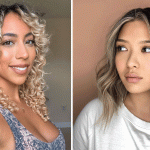Ready to ditch the harsh chemicals and embrace the natural beauty of henna? This guide shows you exactly how to get gorgeous, vibrant hair color using this ancient dye. We’ll walk you through everything from choosing the right henna to perfecting your application technique, and show you stunning before-and-after photos to inspire you. You’ll learn about the amazing benefits (and a few potential drawbacks), so you can make an informed decision and achieve the stunning results you’ve always dreamed of. For more on hair texture, check out this helpful resource on [hair texture powders](https://mearnes.com/hair-texture-powder/). Let’s get started!
Henna Hair Dye Before and After: Your Journey to Naturally Gorgeous Hair
Let’s explore the exciting world of henna hair dye! Prepare to be amazed by the incredible transformations possible with this natural coloring option, known for its hair strengthening properties. We’ll delve into the hows and whys, empowering you to achieve your dream hair color naturally.
What’s the Deal with Henna? A Quick Look
Henna, derived from the Lawsonia inermis plant, has a rich history as a natural hair dye and body art staple. It’s a powder that, when mixed with liquid, releases molecules that stain your hair, giving it those beautiful reddish-brown tones. The final shade? That depends on a bunch of factors we’ll discuss! This natural dye has been used for centuries, offering a chemical-free hair coloring alternative. It’s also known to help restore the natural pH balance of your hair and scalp.
The Good, the Bad, and the Henna: Weighing the Pros and Cons
Henna’s appeal is undeniable. It’s a chemical-free alternative, acting as a natural conditioner while adding a vibrant pop of color. It coats each strand, boosting shine and strength, and the color lasts a surprisingly long time, gradually fading over weeks. It offers a natural hair conditioning treatment. Henna can also make your hair stronger, thicker, and shinier.
However, like any natural dye, henna has its quirks. Outcomes can be a little unpredictable; your hair’s starting color and texture play a huge role. Completely covering gray hair might take several applications or mixing henna with other natural dyes. And let’s be realistic—henna stains! Your skin and clothes are fair game, so always do a test strand first. Mixing henna with other dyes, especially those with metallic salts, can lead to unexpected and potentially damaging results, so proceed with caution. Once you dye your hair with henna, it may be difficult to go lighter in color later, as henna is very hard to lift out of your hair. Understanding the potential drawbacks of henna is crucial before starting.
Henna Types: The Pure Stuff vs. the Mixes
Pure henna contains only the Lawsonia inermis powder – just the good stuff. Blended henna, on the other hand, might contain other ingredients. Some are helpful, others could be harmful. Always check the label thoroughly! Metallic salts are a big no-no; they can cause unpredictable reactions and damage your hair (resulting in a chemical reaction that causes your hair to smoke!). Choose reputable brands that focus on pure henna and clearly list all ingredients. Selecting the right henna product is essential for achieving desired results.
Henna Hair Dye Before & After: Real-Life Transformations
(Insert a captivating before & after gallery here, showcasing diverse hair types and colors. Each image should be captioned with details about the starting hair color, henna type used, and approximate application time.)
Let’s examine some of these amazing transformations! See how the starting hair color significantly impacts the final look? Darker hair might show more subtle changes, while lighter hair could get a bolder, more vibrant red. The quality of the henna you use and how you apply it also greatly affect the final results. You might notice some photos show richer, more even color than others – this likely reflects differences in these key factors. Analyzing real-life henna transformations can inspire and inform your own journey.
Your Step-by-Step Guide to Henna Hair Success
Picking the Right Henna: Choose high-quality, pure henna powder from a trusted source. Examine labels carefully; ensure there are no metallic salts or other questionable additives. Reputable brands like Morrocco Method are known for their pure henna products.
Preparation and Application: The Hands-On Part
- The Strand Test (Crucial!): Before you commit to your whole head, always perform a strand test 24-48 hours beforehand. This helps you preview the color and check for any allergic reactions. This is especially important if you have previously dyed or chemically treated hair. Imagine being able to preview your hair color before the full application, wouldn’t that be amazing?
- Mixing It Up: Follow the instructions on your henna package for mixing the powder with liquid (often water, or a mix of water and ingredients like lemon juice, coffee, or tea). The consistency should be like a smooth paste – not too runny, not too thick. Did you know that lemon juice enhances the color intensity? For darker shades, try coffee or tea.
- Application Time: Apply the henna paste evenly to clean, dry hair, section by section. Use gloves to avoid staining your hands, and apply a thick balm or cream around your forehead, ears, and neck to protect your skin. A plastic cap helps keep everything in place. Proper henna application is important, right?
- Processing Time: Let the henna do its thing for the recommended time (typically 1-6 hours, depending on the desired intensity; some can even leave it on overnight). Keep the dye warm by wrapping your hair with a shower cap or plastic wrap. Consider this as a spa treatment for your hair.
- Rinsing: Rinse thoroughly with cool water until the water runs clear. Avoid using shampoo right away; let your hair rest for 24-48 hours to allow the color to fully develop. Cool water helps preventing color fading, doesn’t it?
Post-Henna Care: Keeping Your Hair Happy
- Use gentle, sulfate-free shampoos and conditioners to maintain the color and keep your hair healthy and shiny. These products helps maintain color and hair health.
- Avoid extreme heat styling (like flat irons or curling irons) to help prevent color fading. This way, you are protecting the vibrant hair color.
- Deep condition regularly to keep your hair moisturized and strong. Consider using a hair serum designed to nourish your hair and enhance the vibrancy of the henna color.This helps maintain both color and overall hair health.
- Reduce the frequency of your hair washes to prolong your color.
Troubleshooting: Addressing Potential Hiccups
- Uneven Color? Make sure the henna is mixed thoroughly and applied evenly. Ensure you are using a consistent application technique. Practice makes perfect!
- Staining? Use petroleum jelly or coconut oil around your hairline to protect your skin from unexpected staining. Apply before you start the application process.
- Removal? Henna color is notoriously tough to remove. If you’re unhappy with the results, consult a professional stylist. Be prepared that lightening your hair with bleach may not be easily achievable.
Frequently Asked Questions (FAQ)
- How long does the color last? The vibrant color usually lasts for 4-6 weeks, although some staining might remain longer. Henna offers a long-lasting natural dye solution, doesn’t it?
- Can I use henna after chemical dyes? Generally, it’s not recommended; compatibility issues might occur. It’s important to let your hair dresser know that you’ve dyed your hair with henna before you get started, so they are prepared. Avoid chemical dyes can prevent any reactions.
- Can I use other dyes after henna? This is tricky and depends on the type of dye you use. Semi-permanent dyes often produce mixed results. Lightening with bleach is especially difficult after using henna. It’s best to consult a professional stylist before attempting this.
- Will henna cover gray hair? Yes, henna can cover gray hair, but it may require multiple applications or mixing with other natural dyes like indigo for complete coverage.
- Can henna dry out my hair? Leaving henna on for too long can dry out your hair. Be sure to follow the recommended processing time and deep condition afterwards.
Henna vs. Chemical Dyes: A Quick Comparison
| Feature | Henna | Chemical Dyes |
|---|---|---|
| Ingredients | All-natural (Lawsonia inermis) | Synthetic chemicals |
| Color Choices | Limited; mostly reddish-brown shades | Vast range of colors |
| Hair Health | Conditioning, strengthening | Can be damaging, depending on the type |
| Predictability | Less predictable | More predictable |
| Application | More time-consuming | Relatively quick and easy |
| Cost | Varies; can be affordable or pricey | Generally more expensive |
| Permanence | Permanent | Semi-permanent or permanent |
Remember, your henna hair dye journey is just that—a journey! Enjoy the process, manage your expectations, and celebrate the natural beauty henna can bring to your hair. Embrace the potential for unique and stunning results! Understanding the difference between henna and chemical dyes helps you make an informed decision.
How to Achieve Specific Henna Hair Dye Shades Using Natural Additives
Key Takeaways:
- Henna, a natural dye, offers conditioning benefits and customizable
- Achieve Anesthesiology Work-Life Balance: Your Guide - December 4, 2025
- Unlock Young Doctors’ Work-Life Balance: Actionable Strategies Now - December 2, 2025
- Unlock Life Harmony: Work-Life Integration Guide - November 30, 2025
















